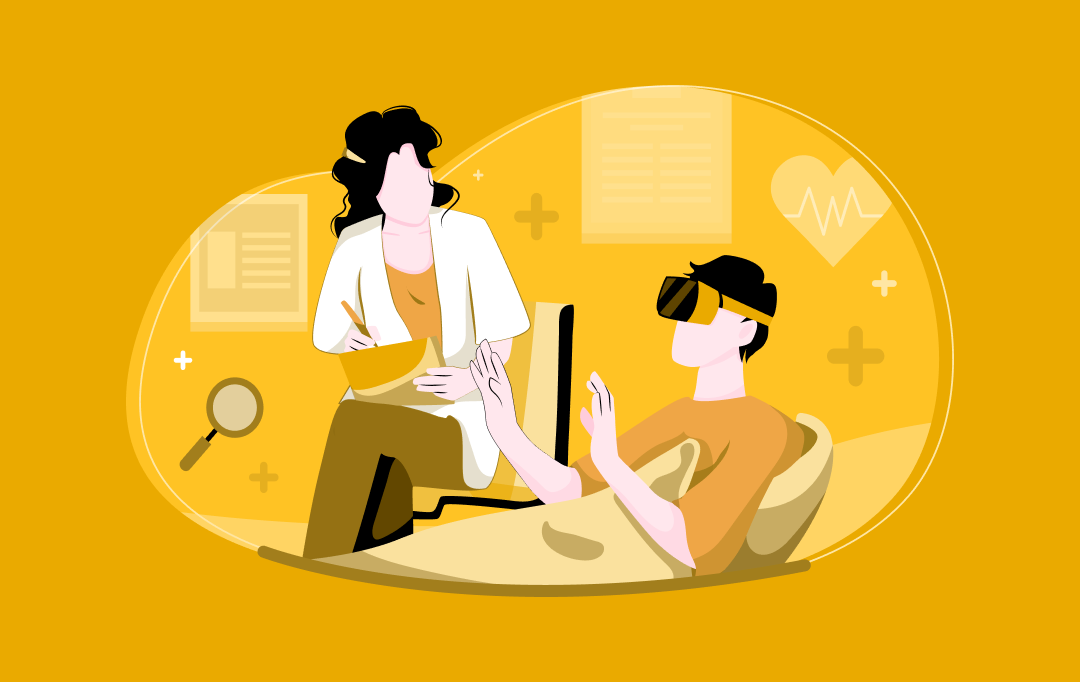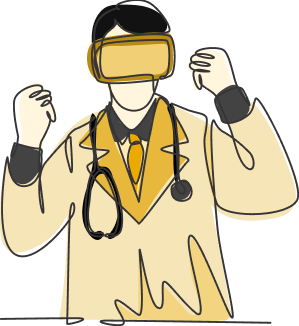- Understanding Virtual Reality's Role in Mental Health Treatment
- Top 10 Use Cases of Virtual Reality in Mental Health Treatment
- 1. Exposure Therapy for Phobias and PTSD
- 2. Managing Anxiety Through Immersive Relaxation
- 3. VR-Assisted Cognitive Behavioral Therapy (CBT)
- 4. Treatment of Depression with Virtual Environments
- 5. Pain Management and Distraction Techniques
- 6. Social Skills Training for Autism Spectrum Disorders
- 7. Enhancing Mindfulness and Meditation Practices
- 8. VR for Addiction Recovery and Craving Reduction
- 9. Sleep Disorders and VR-Induced Relaxation
- 10. Supporting Rehabilitation in Traumatic Brain Injury (TBI)
- Business Benefits of Integrating VR in Mental Health Apps
- Increased Patient Engagement and Compliance
- Data-Driven Personalization and Adaptive Therapies
- Remote Access and Teletherapy Advantages
- Cost-Effectiveness Compared to Traditional Therapies
- Scalability and Integration with AI and IoT Technologies
- Enhanced Clinical Validation and Evidence-Based Treatment
- Improved Patient Safety and Comfort
- Competitive Differentiation and Innovation Leadership
- Long-Term Patient Empowerment and Self-Management
- Overcoming Key Challenges in Developing VR Mental Health Solutions
- Software Accessibility and User Inclusivity
- Compliance with Data Privacy and Security Regulations
- Designing User Experience for Vulnerable Populations
- Clinical Validation and Regulatory Approvals
- Integration with Existing Healthcare Systems
- Future Outlook: The Next Frontier of VR in Mental Health
- Emerging Technologies Amplifying VR Impact
- How Forward-Thinking Organizations Can Stay Ahead
- Accelerate Mental Health Outcomes Through VR App Development with Appinventiv
- FAQs
- Virtual Reality is revolutionizing mental health care, providing immersive treatments for disorders like anxiety, PTSD, and phobias, leading to more engaged and effective therapy.
- Key VR use cases in mental health include exposure therapy, cognitive behavioral therapy (CBT), addiction recovery, and pain management, offering personalized and scalable solutions.
- The benefits of VR in mental health include enhanced patient engagement, customized treatment plans, reduced healthcare costs, and increased access to care for underserved populations.
- Challenges to VR adoption involve high upfront costs, strict data privacy requirements, and the need for thorough clinical validation and regulatory approvals.
In January 2024, the California Department of Health Care Services (DHCS) took a significant step toward modernizing behavioral health support by launching the Behavioral Health Virtual Services Platform. Designed for families and young individuals aged 0–25, this dual-application platform is a cornerstone of the Kids’ Mental Health campaign and the Children and Youth Behavioral Health Initiative (Source: CYBHI). It marks a pivotal shift in how mental health services are delivered and accessed.
This initiative also signals a broader transformation in the mental health landscape, one where technology plays a central role in expanding reach and impact. With nearly one in five adults worldwide experiencing mental health disorders, traditional therapy often falls short in terms of accessibility and engagement. Virtual reality in mental health is emerging as one such innovative tool to bridge this gap.
According to a report by McKinsey, over half the population in middle- and high-income countries will experience a mental health condition in their lifetime. Since the onset of the COVID-19 pandemic, approximately 42% of employees worldwide have reported a decline in mental well-being, highlighting the urgent need for virtual reality for mental health as part of scalable and engaging therapeutic interventions.
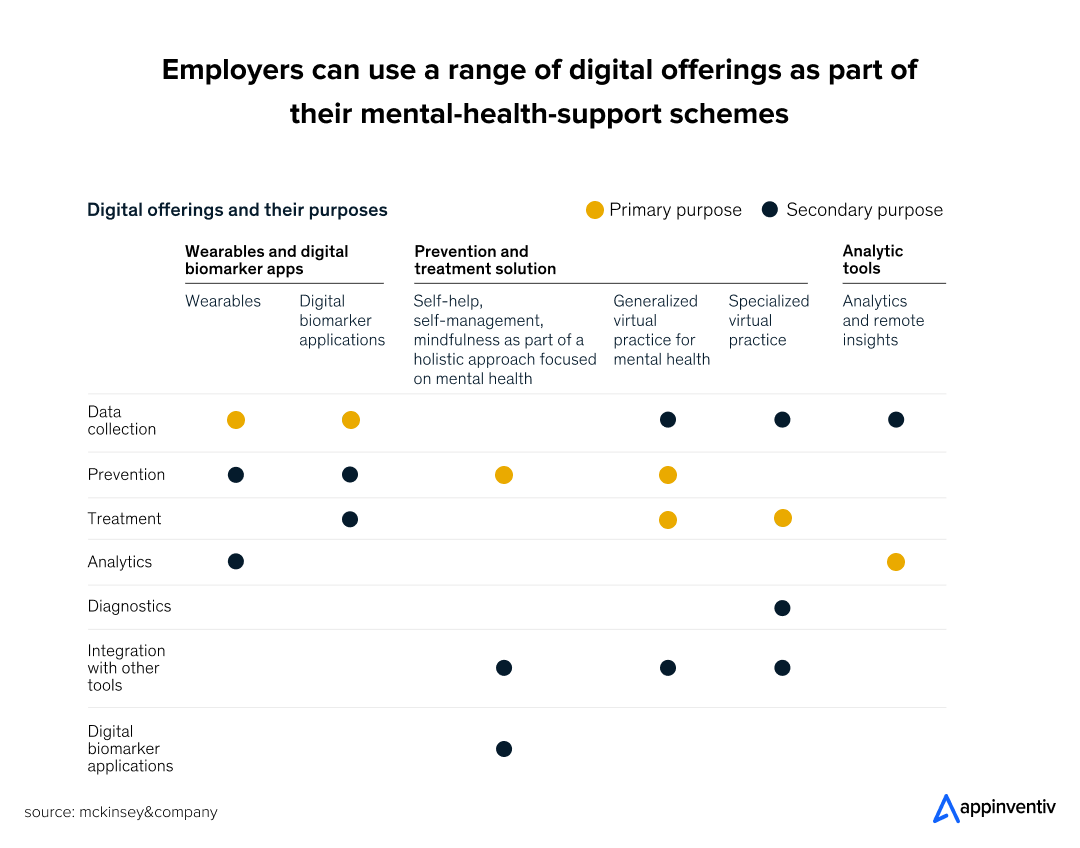
Enter Virtual Reality in mental health—a powerful alternative that delivers immersive, effective, and personalized experiences for patients. By simulating real-life scenarios in a safe and controlled setting, VR enables deeper engagement and tailored therapy that adapts to individual needs. This breakthrough not only enhances treatment outcomes but also expands access for those who face barriers to traditional care, paving the way for a more inclusive and transformative approach to mental health.
By simulating real-world environments, VR in therapy can help individuals manage conditions such as anxiety, PTSD, and phobias with greater ease and realism than conventional methods. More importantly, it reaches those who might feel disconnected from or intimidated by traditional clinical settings. As innovation accelerates, virtual reality for mental health is quickly evolving from an experimental tool to a vital component of modern care.
In this blog, we’ll explore the top 10 use cases of virtual reality in mental health. But before diving into the applications, we’ll examine its core role, business benefits, and key challenges, ending with a forward-looking perspective on what the future holds. Let’s get started.
Be the innovator who brings real relief with an immersive, user-centric mental health solution.
Understanding Virtual Reality’s Role in Mental Health Treatment
Virtual Reality (VR) is reshaping the future of mental health treatment by offering immersive, controlled environments where individuals can safely engage in therapeutic experiences that were once difficult or impossible to recreate in traditional clinical settings. This cutting-edge approach allows mental health professionals to guide patients through custom-designed scenarios that help address a range of conditions, from phobias and PTSD to anxiety, depression, and stress-related disorders.
Unlike conventional methods, VR therapy enables practitioners to create highly personalized, repeatable, and scalable interventions. These virtual environments offer precise stimulus control, which is crucial for therapies like exposure treatment or social skills training. Patients can interact with these simulations in real time, and clinicians can monitor their reactions using biometric data, ensuring that the therapy is both effective and responsive to individual needs.
The key to the success of virtual reality therapy lies in the brain’s ability to perceive virtual experiences as real. By hijacking sensory perception—through sight, sound, and sometimes touch—VR induces a psychological phenomenon called presence. This state leads to authentic emotional and physiological responses, making the therapeutic impact of virtual experiences comparable to, and in some cases more effective than, real-world exposure, all while maintaining safety and control.
Incorporating VR in therapy opens up new possibilities for mental health care delivery, especially in underserved or remote areas where access to in-person treatment is limited. It also provides an engaging alternative for individuals who may feel uncomfortable with traditional talk therapy formats. With the ability to measure outcomes, adjust scenarios on the fly, and offer consistent, evidence-based protocols, VR mental health solutions are poised to become a vital part of the mental health ecosystem.
As technology continues to evolve, virtual reality therapy is not just a promising innovation—it’s a powerful tool that’s redefining how we understand, treat, and manage mental well-being in the digital age.
Also Read: The Role of Virtual Reality in Healthcare
Top 10 Use Cases of Virtual Reality in Mental Health Treatment
Virtual Reality (VR) is transforming the way mental health disorders are understood and treated. By creating immersive, controlled environments, VR enables therapists to deliver more personalized, engaging, and effective care. Explore the top 10 real-world use cases where VR is making a meaningful impact on mental well-being.
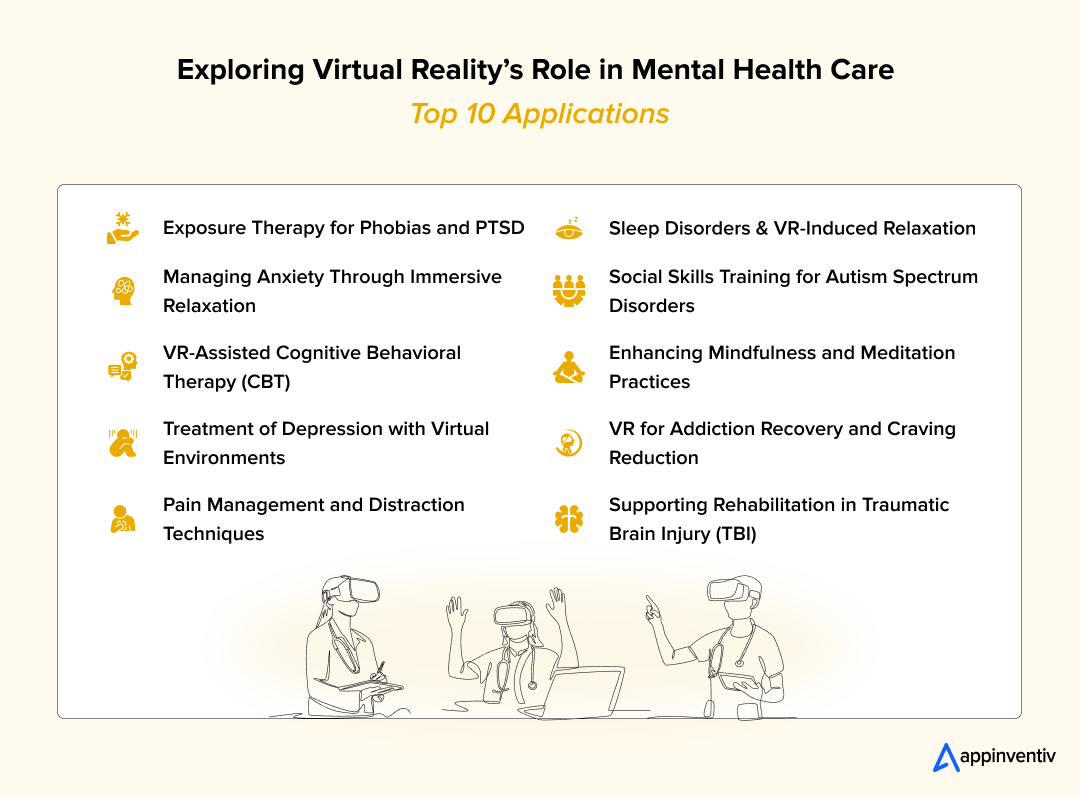
1. Exposure Therapy for Phobias and PTSD
Exposure therapy is a widely used treatment for phobias and PTSD that helps patients confront fears in a safe, controlled environment. Virtual reality in mental health enhances this therapy by immersing patients in realistic, customized scenarios that mimic their triggers. This controlled approach accelerates desensitization and reduces anxiety symptoms more effectively than traditional methods. It’s scalable, repeatable, and accessible remotely, making it ideal for broad deployment.
Real-life Example: Johnson & Johnson’s Janssen Pharmaceutical collaborated with Oxford VR to create virtual reality therapy examples aimed at PTSD, especially in military veterans. Their VR applications have advanced through clinical trials and aim for FDA approval, demonstrating significant symptom reduction. This partnership highlights how a Fortune 500 pharma leader is advancing scalable, technology-driven mental health treatments.
2. Managing Anxiety Through Immersive Relaxation
Immersive VR environments designed for relaxation help users lower anxiety and stress levels by providing calming, distraction-rich experiences. These sessions use soothing visuals, guided breathing, and mindfulness techniques to reduce cortisol and other stress markers. Virtual reality in mental health applications like these improves therapy engagement and makes mental health support accessible beyond clinical boundaries.
Real-life Example: Merck & Co. partnered with AppliedVR to deliver immersive VR modules to hospital patients. These experiences led to a 30% reduction in reported anxiety, showcasing how VR for mental health can enhance patient well-being during hospitalization.
3. VR-Assisted Cognitive Behavioral Therapy (CBT)
VR-assisted CBT allows patients to practice coping strategies in interactive, realistic environments. This boosts engagement and enables therapists to customize sessions dynamically. The integration of VR and mental health strategies helps bridge the gap between clinical learning and real-world application.
Real-life Example: Pfizer has shown growing interest in the potential of immersive technologies like Virtual Reality (VR) to enhance mental health treatments, particularly in the area of Cognitive Behavioral Therapy. By integrating VR into clinical research and therapeutic programs, Pfizer is exploring how immersive environments can improve patient outcomes in conditions such as anxiety, depression, and PTSD.
4. Treatment of Depression with Virtual Environments
Incorporating virtual reality therapy into mental health care enables the design of uplifting environments that foster emotional healing and social interaction. These immersive experiences stimulate emotional regulation and motivation by exposing patients to uplifting virtual settings and social scenarios. They serve as adjunctive therapy, helping patients re-engage with daily life and reduce feelings of isolation.
Real-life Example: CVS Health uses virtual reality therapy for depression as part of its wellness hubs, providing customers with mood-enhancing VR experiences aimed at alleviating depression. These tools complement CVS’s behavioral health services by offering accessible, on-demand mental health support to a wide patient base.
5. Pain Management and Distraction Techniques
VR distracts patients from pain by immersing them in engaging virtual environments, which shifts focus away from discomfort. This technique is especially effective during painful procedures or chronic pain episodes. VR can reduce perceived pain up to a certain extent, enabling lower doses of pain medication and improving patient comfort and recovery. This strategy is gaining traction as a part of virtual reality healthcare innovations.
Real-life Example: Medtronic uses VR distraction therapy in pain management protocols, reducing opioid use and improving rehabilitation outcomes. Their VR applications have been integrated into chronic pain treatment plans and post-surgical care, reflecting Medtronic’s commitment to innovative, patient-centered therapies.
6. Social Skills Training for Autism Spectrum Disorders
Using virtual reality in therapy, individuals on the autism spectrum can practice social interactions through role-playing in virtual scenarios. Virtual environments simulate real-life social interactions, allowing repeated practice in a low-risk setting. This method improves social engagement and confidence, supported by research demonstrating increased social responsiveness after VR interventions.
Real-life Example: Abbott Laboratories is currently exploring partnerships with VR therapy startups to develop social skills training applications for children on the autism spectrum. Using immersive role-play, these VR solutions help improve communication and interaction, with clinical data supporting measurable gains in social behaviors.
7. Enhancing Mindfulness and Meditation Practices
VR-guided mindfulness and meditation applications help users focus attention, regulate emotions, and reduce negative thought patterns. The immersive experience enhances relaxation and engagement, often producing greater benefits than traditional audio- or video-based practices. The use of mental health virtual reality platforms supports ongoing emotional resilience.
Real-life Example: UnitedHealth Group integrates VR mindfulness applications into their behavioral health offerings. Their use of VR meditation helps members reduce stress and improve mental focus, contributing to better health outcomes and lower healthcare costs.
8. VR for Addiction Recovery and Craving Reduction
Virtual reality therapy software simulates real-world addiction triggers in a controlled environment, allowing patients to practice avoidance and coping strategies safely. Through repeated exposure without real-world consequences, patients develop resilience and reduce their risk of relapse. VR also supports craving management through immersive behavioral therapies.
Real-life Example: XRHealth has integrated VR therapy into its telehealth services for substance abuse. Patients receive a VR kit at home, then join live sessions with a dedicated recovery specialist who tailors immersive scenarios, such as virtual parties or stressful social encounters, to each individual’s triggers. Through repeated practice in these virtual environments, patients report reduced cravings and improved coping skills, enhancing overall treatment outcomes.
9. Sleep Disorders and VR-Induced Relaxation
VR applications designed for individuals with sleep disorders utilize calming visuals and guided relaxation techniques to enhance sleep onset and quality. These immersive experiences reduce sleep latency and increase REM sleep cycles, offering non-pharmacological alternatives to traditional sleep aids. Incorporating virtual reality mental health interventions in sleep hygiene routines provides a non-drug-based path to better rest.
Real-life Example: Helium, a clinically validated VR and AR platform, has been used by individuals with stress-related sleep issues. Its immersive mindfulness environments and biofeedback-driven content help calm the nervous system before bedtime. In clinical trials and pilot programs, users have reported improved sleep onset and reduced anxiety, making Helium a promising tool in addressing sleep disorders without medication.
Also Read: Cost to Develop a Meditation App Like Calm
10. Supporting Rehabilitation in Traumatic Brain Injury (TBI)
Virtual reality in mental health rehabilitation combines cognitive exercises with motor training in interactive environments. These applications enhance neuroplasticity and functional recovery, reducing rehabilitation time and improving outcomes in daily living skills.
Real-life Example: UnitedHealth Group utilizes VR rehabilitation solutions for TBI patients to accelerate recovery and improve motor and cognitive functions. Their applications have demonstrated faster return-to-function rates and lower long-term care costs, reflecting the efficacy of VR in complex rehabilitation.
Business Benefits of Integrating VR in Mental Health Apps
Integrating Virtual Reality into mental health apps unlocks immersive, personalized care experiences that boost user engagement and clinical effectiveness. This not only drives better treatment outcomes but also helps businesses gain a competitive edge and explore new revenue opportunities. Here are the top benefits of incorporating VR into mental health solutions.
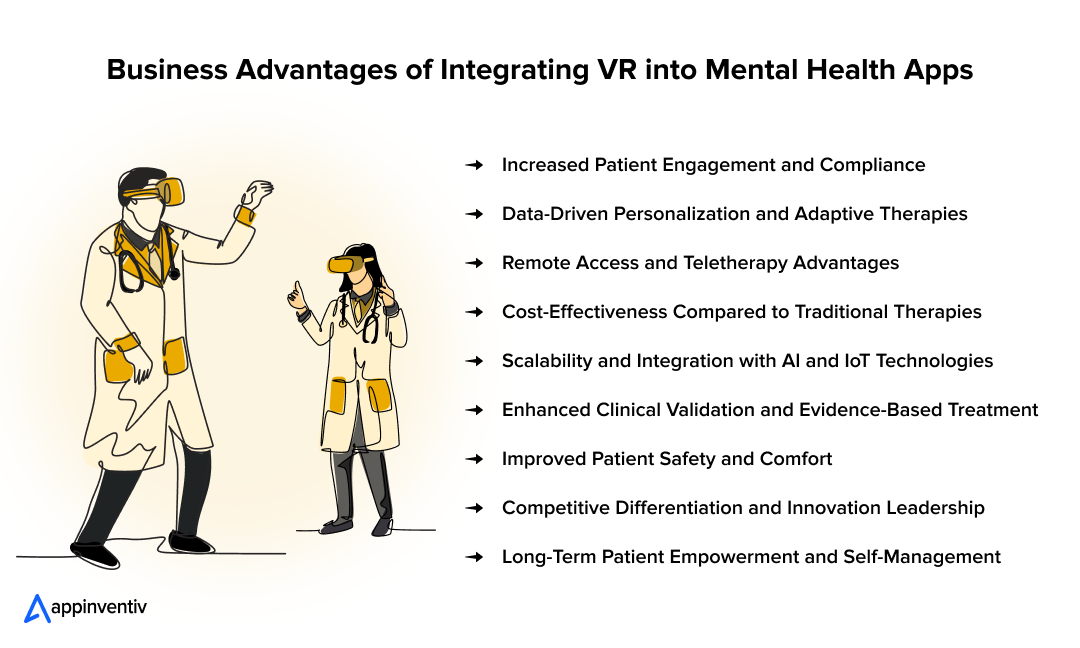
Increased Patient Engagement and Compliance
Virtual reality’s immersive and interactive nature creates a compelling therapy experience that keeps patients motivated and focused. This leads to higher engagement compared to traditional talk therapy or self-guided digital tools, significantly reducing dropout rates.
Virtual reality therapy for anxiety disorders demonstrates how these immersive sessions improve motivation and follow-through in patients with complex conditions. Better engagement drives improved adherence to treatment protocols, which directly correlates with faster symptom relief and improved long-term outcomes. For healthcare providers, this means more effective use of therapy time and better patient satisfaction scores.
Data-Driven Personalization and Adaptive Therapies
VR platforms gather granular data on patient interactions, physiological responses, and progress metrics, enabling real-time personalization of treatment. Therapists can tailor the intensity, pacing, and type of exposure or exercises based on individual patient needs, rather than relying on a one-size-fits-all model.
This adaptive therapy approach enhances clinical efficacy and helps identify early signs of relapse or non-compliance, allowing timely intervention. It also supports precision medicine principles, increasing the chances of lasting recovery. These capabilities reflect emerging virtual reality use cases for mental health that prioritize personalization and predictive care.
Remote Access and Teletherapy Advantages
By removing geographical and logistical barriers, virtual reality mental health apps make high-quality therapy accessible anytime and anywhere. This is particularly valuable for patients in remote, underserved, or mobility-limited populations who may otherwise face long wait times or travel burdens.
VR teletherapy maintains engagement and clinical effectiveness by providing immersive experiences that replicate in-person sessions. For healthcare systems, this translates into optimized resource utilization and expanded patient reach without increasing physical infrastructure costs. Such innovations highlight the benefits of VR in mental health disorders, especially in increasing access and equity.
Cost-Effectiveness Compared to Traditional Therapies
While upfront VR app development costs exist, long-term savings are substantial. VR therapy reduces the frequency of costly in-person visits and cuts down on associated overhead expenses. Its scalability enables healthcare providers to serve more patients simultaneously without proportional increases in staffing or facility requirements.
Additionally, improved patient adherence and faster recovery reduce hospitalization rates and chronic care costs, resulting in higher ROI for payers and providers alike. This is a significant value proposition driving the adoption of virtual reality in mental health across global care ecosystems.
Scalability and Integration with AI and IoT Technologies
VR mental health solutions can easily scale to serve large populations without compromising quality or personalization when integrated with AI and IoT technologies. The use of AI in mental health app development allows for real-time analysis of patient data, enabling personalized therapy experiences and accurate prediction of treatment responses for more effective and tailored care.
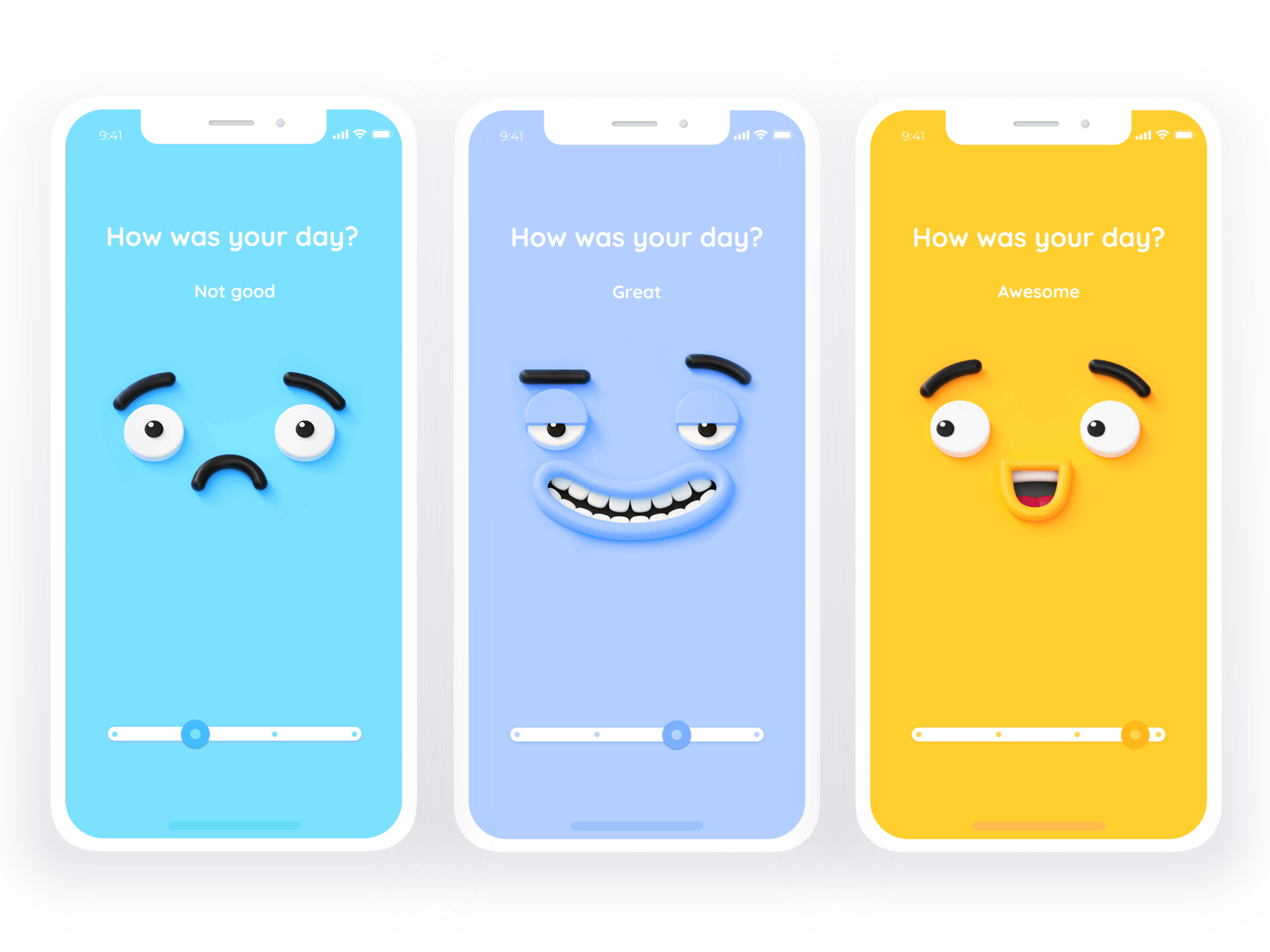
Again, IoT devices can monitor biometric data (heart rate, stress levels) to inform therapy adjustments in real time. These advantages underscore the growing role of virtual reality in mental health for a future-ready digital healthcare infrastructure.
Also Read: Understanding the Impact of IoT in Healthcare
Enhanced Clinical Validation and Evidence-Based Treatment
VR allows standardized delivery of therapy protocols with precise control over stimuli and environments, improving the reproducibility of clinical studies. This consistency supports stronger clinical validation and regulatory approval processes, which build trust among healthcare providers and payers.
As evidence accumulates, VR-based treatments increasingly gain reimbursement support, driving wider adoption and sustainable business growth. These factors illustrate why VR therapy is earning credibility and recognition as a validated treatment pathway.
Improved Patient Safety and Comfort
Patients can undergo challenging therapeutic exposures or skill-building exercises within a safe, controlled VR environment, reducing the risk of adverse events. This safety net encourages patients to confront difficult issues without fear, enhancing therapeutic impact.
VR also allows gradual intensity increases tailored to tolerance levels, minimizing dropouts due to discomfort. Overall, this creates a more patient-friendly experience that improves treatment uptake. This safety-driven approach reinforces how virtual reality mental health solutions are designed with both care and comfort in mind.
Competitive Differentiation and Innovation Leadership
For healthcare organizations and tech providers, integrating VR in mental health offerings signals innovation, leadership and a commitment to cutting-edge care. Early adoption helps capture market share in a rapidly growing digital therapeutics space valued at billions globally.
Demonstrated success with VR-based therapies can enhance brand reputation, attract new partnerships, and open revenue streams from new payer models and value-based care contracts. This reflects the strategic advantage of investing in virtual reality therapy as part of digital health innovation.
Long-Term Patient Empowerment and Self-Management
VR apps empower patients with interactive tools and exercises they can access independently, fostering self-efficacy in managing mental health. This reduces dependence on clinical visits and supports maintenance of wellness post-treatment.
Features like guided mindfulness, coping skill rehearsals, and progress tracking help patients stay engaged and proactive, reducing relapse risk and chronic condition burden. This patient-centric approach exemplifies the growing success of VR in therapy as a self-management tool for mental wellness.
Overcoming Key Challenges in Developing VR Mental Health Solutions
Virtual reality in mental health holds immense potential in mental health care, but its development and deployment come with significant hurdles. Addressing these challenges is critical for delivering effective, compliant, and scalable VR therapies that meet the needs of patients and healthcare providers alike. Below, we outline the primary obstacles alongside actionable solutions to guide successful VR mental health app development.

Software Accessibility and User Inclusivity
One of the major challenges in deploying VR-based mental health solutions is ensuring software accessibility for diverse user groups. Complex navigation, unintuitive interfaces, and a lack of language or accessibility support can alienate users, especially those with cognitive challenges, disabilities, or low digital literacy. Such limitations reduce the effectiveness and reach of mental health interventions.
Solution: To make VR and mental health truly inclusive, businesses must design intuitive, user-friendly interfaces with clear guidance, multilingual support, and customizable user journeys. Features like voice navigation, adjustable visuals, and simplified onboarding can significantly enhance accessibility.
Compliance with Data Privacy and Security Regulations
Security and compliance are critical components of trusted virtual reality healthcare applications. Mental health data is highly sensitive, making strict adherence to regulations like HIPAA (US), GDPR (EU), and other regional privacy laws essential. Navigating the complexity of these standards while ensuring secure data storage, transmission, and access can be daunting, increasing legal risks and development overhead.
Solution: Incorporate privacy-by-design principles from the outset, implementing end-to-end encryption, role-based access controls, and continuous security audits. Collaborate with legal and compliance experts to ensure ongoing alignment with evolving regulations. Transparent privacy policies and patient consent protocols build user trust and regulatory confidence.
Designing User Experience for Vulnerable Populations
Mental health patients often have diverse and sensitive needs, requiring VR experiences that minimize discomfort, confusion, or adverse reactions. Poorly designed interfaces can alienate users or worsen symptoms, undermining treatment efficacy and increasing dropout rates.
Solution: Engage mental health professionals, UX designers specialized in accessibility, and patient representatives early in the design process. Conduct iterative usability testing with diverse user groups to identify and resolve pain points. Incorporate customizable settings that allow users to control stimulus intensity, session length, and navigation ease for a safer, more comfortable experience. Such considerations ensure that mental health virtual reality solutions are therapeutic and inclusive.
Clinical Validation and Regulatory Approvals
To gain acceptance among clinicians and payers, VR mental health solutions must demonstrate safety and efficacy through rigorous clinical trials and secure regulatory approvals. This process is time-consuming and expensive, often delaying product launch and market penetration. However, these steps are essential for advancing virtual reality therapy in mental health into mainstream care.
Solution: Develop standardized protocols for clinical evaluation aligned with regulatory guidelines. Partner with academic institutions or clinical research organizations to conduct robust trials. Early engagement with regulatory bodies helps clarify requirements, accelerating approval. Publishing validated outcomes strengthens credibility and facilitates reimbursement discussions.
Integration with Existing Healthcare Systems
VR mental health apps must seamlessly integrate with EMR, EHR, telehealth platforms, and provider workflows to enable coordinated care. Fragmented systems and proprietary formats create technical and operational barriers that limit VR’s scalability and adoption.
Solution: Adopt interoperable standards like HL7 FHIR for data exchange and APIs that facilitate smooth integration. Collaborate closely with healthcare IT teams to understand workflows and compliance requirements. Offering modular, customizable integration solutions ensures VR apps complement existing infrastructure, enhancing provider acceptance and user experience. This approach supports broader adoption of virtual reality therapy for depression and related interventions across healthcare ecosystems.
Let us simplify the complexities so you can focus on better outcomes.
Future Outlook: The Next Frontier of VR in Mental Health
Virtual reality in mental health stands at an inflection point where VR will fundamentally reshape treatment delivery, patient outcomes, and business models. The next decade will see immersive technologies shift from being supplementary tools to becoming core infrastructure, powering personalized, scalable, and data-driven virtual reality for mental health interventions. Strategic leaders must understand these transformation vectors to position their organizations to capitalize on market opportunities.
Emerging Technologies Amplifying VR Impact
Haptic feedback systems add tactile sensations to virtual reality in therapy, enhancing immersion and enabling new intervention types like virtual touch therapy for trauma patients. Brain-computer interfaces promise direct neural feedback for unprecedented precision in mental health treatment.
5G networks will enable cloud-based VR mental health processing, reducing hardware costs while improving visual quality and reducing latency that currently limits some therapeutic applications.
How Forward-Thinking Organizations Can Stay Ahead
Early adopters of virtual reality (VR) mental health solutions often experience significant competitive advantages. By enhancing patient satisfaction, streamlining operational costs, and offering unique, tech-forward services, these organizations position themselves as leaders in modern care delivery.
As immersive digital therapies become more mainstream, forward-thinking healthcare providers can build stronger patient loyalty, attract new referrals, and stand out in a crowded market. Embracing VR early allows institutions to refine their processes, build clinical evidence, and stay ahead of evolving patient expectations.
Organizations should begin pilot applications now to build expertise, establish clinical evidence, and develop operational processes before virtual reality in mental health becomes standard care expectation.
Accelerate Mental Health Outcomes Through VR App Development with Appinventiv
Virtual Reality is rapidly redefining the boundaries of mental healthcare, ushering in an era where emotional healing is no longer confined to the therapist’s office. In a world strained by rising psychological burdens and an overstretched care system, virtual reality in mental health offers a radical new path: immersive environments where individuals can safely explore their fears, confront trauma, and rebuild resilience with unprecedented autonomy and engagement.
We’re entering a future where therapy becomes experiential—where AI-enabled VR therapy systems will personalize care in real time, respond to biometric cues, and evolve with each session. These digital experiences won’t just supplement traditional therapy; they’ll transform it, making virtual reality for mental health support proactive, continuous, and deeply human.
At the forefront of this evolution is Appinventiv, a globally leading custom healthcare software development company. We empower healthcare pioneers to turn breakthrough ideas into real-world impact. Backed by a history of delivering groundbreaking healthcare solutions like Health-e-People, Soniphi, and DiabeticU, we help healthcare innovators turn ambitious ideas into measurable impact. Our expertise spans the entire digital health spectrum, rooted in clinical understanding, driven by user-centric design, and reinforced by regulatory compliance.
While countless technology vendors promise healthcare innovation, Appinventiv delivers transformational solutions that reshape entire care delivery models. As a global leader in healthcare app development services, we don’t simply build applications—we architect digital ecosystems that drive measurable business outcomes and clinical excellence across international markets.
Let’s shape a reality where healing is immersive, intelligent, and truly transformative. Get in touch now!
FAQs
Q. How does VR therapy work?
A. VR therapy immerses patients in controlled, interactive virtual environments designed to simulate real-world scenarios relevant to their mental health conditions. This immersion enables safe exposure, skill practice, or relaxation in ways traditional therapy cannot. Sensors track patient responses, allowing therapists to personalize treatment dynamically, enhancing engagement and accelerating recovery.
Q. What are the typical costs involved in implementing VR technology in mental health apps?
A. Implementing virtual reality in mental health apps involves several cost components. Development costs for a custom VR mental health app generally fall between $100,000 and $500,000, influenced by features such as interactive environments, real-time data tracking, and clinical validation.
Additional expenses may include ongoing maintenance, updates, user training, and compliance measures. While implementation requires substantial initial funding, the scalable nature of VR therapy often leads to reduced long-term treatment costs and improved patient outcomes, delivering strong value over time.
Q. Which mental health conditions benefit most from VR therapies?
A. Virtual reality therapy has demonstrated strong effectiveness for conditions such as PTSD, phobias, anxiety disorders, depression, addiction, and autism spectrum disorders. Its immersive nature is particularly valuable for exposure therapy, cognitive behavioral therapy, relaxation training, and social skills development, making it versatile across diverse treatment needs.
Q. How are competitors or peers in our industry leveraging VR for mental health care?
A. Leading healthcare organizations and pharmaceutical companies are partnering with VR development services providers to integrate immersive therapies into clinical practice, expand teletherapy options, and enhance patient engagement. They are using VR to complement existing treatment models, validate clinical outcomes through research, and position themselves as innovators in digital therapeutics.
Q. What are the top use cases of VR in treating mental health disorders today?
A. The most prominent use cases include:
- Exposure therapy for PTSD and phobias
- VR-assisted cognitive behavioral therapy (CBT)
- Immersive relaxation for anxiety and stress
- Addiction recovery support and craving reduction
- Social skills training for autism spectrum disorders
- Pain distraction and management
- Depression treatment through virtual environments
- Sleep disorder management using VR relaxation
- Rehabilitation for traumatic brain injury (TBI)



Smart Hospitals - How Modern Technology Is Enhancing Healthcare Operations
Key takeaways: Smart hospitals use AI, IoT, and automation to improve patient care, streamline operations, and reduce costs. 75% of healthcare executives view digital and AI transformation as essential, with high satisfaction among those investing in robotics (82%) and advanced analytics (81%). IoT-enabled patient monitoring and AI diagnostics are revolutionizing clinical decision-making and reducing risks…

Why EHR-CRM Integration is Essential for Modern Healthcare and How to Do it Right
Key takeaways: EHR-CRM Integration enables personalized care by combining clinical and patient interaction data into a unified profile. It streamlines workflows, reduces redundant data entry, and enhances operational efficiency. Integration optimizes patient acquisition, retention, and billing accuracy, driving revenue growth. It improves clinical outcomes by enabling faster, data-driven decision-making and timely interventions. Ever feel like…

Exploring the Role of Healthcare APIs as a Strategic Business Asset for Competitive Advantage
Key takeaways: Strategic Asset: Healthcare APIs drive data exchange, care coordination, and digital transformation. Regulatory Push: Mandates like the 21st Century Cures Act and HL7 FHIR enforce API adoption. Patient-Centric: APIs enable apps to integrate appointments, test results, and wearable data. Cloud Integration: APIs connect scalable cloud systems for telehealth and AI diagnostics. Automation: APIs…






